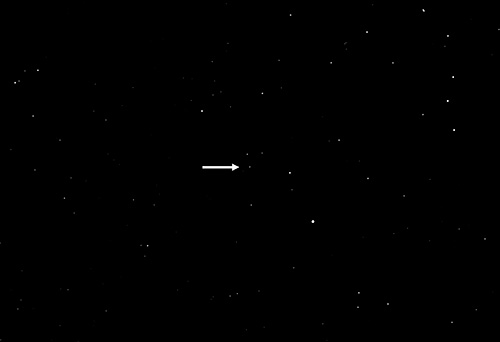Quasar 3C 273
Click on photo for larger image.
That's no star... This looks like a photograph of an unexceptional star field. But the faint object the arrow is pointing to is very different from a star--it's a quasar. The name quasar is derived from "quasi-stellar object," an object that looks like a star but has very unusual characteristics.
In the 1950's, astronomers identified some very bright radio sources in the sky. The location of hundreds of such sources were tabulated in the Third Cambridge Catalogue of Radio Sources (3C) in 1959. Some were eventually associated with visible objects that were point-like, rather than being clearly galaxies. The the patterns of spectral lines for these objects were perplexing; they looked different from the usual signatures of atoms. Did they indicate some new form of matter?
In 1963, Maarten Schmitt obtained the visible spectrum of 3C 273. He identified the spectrum as the normal atomic emmission lines, but shifted substantially toward the red end of the spectrum from their usual positions. This large red shift meant the object was traveling 16% of the speed of light due to the expansion of the universe. It must therefore be more than 2 billion light years distant. But how could anything that far away be visible from earth? No known physical process could produce such astonishing luminosity. It is more than 4 trillion times as luminous as our sun. If 3C 273 were as close as the star Pollux, 34 light years away, it would still shine brighter in the sky than the sun.
For years the mechanism of such brightness remained a mystery. I read about 3C 273 in 1969 and wrote an eighth-grade paper on the puzzle of the quasar energy source. By the late 1980's an explanation emerged as the reality of gravitational black holes became more widely accepted. Quasars are now understood to be active super-massive black holes at the center of galaxies. They are "active" in that they are consuming large amounts of their neighborhoods--shredded stars, dust, and gas. Before the material enters the black hole, it is heated by compression and friction; the result is an enormous amount of radiation. Quasars are brighter than their whole host galaxies. This also explains the observed variability in the quasar brightness due to non-uniform ingestion of the accretion disk around the black hole. More than a million other quasars have now been catalogued. Star distances are measured in light-years, galaxies in millions of light-years. The farthest quasar is more than 13 billion light years away.
3C 273 was the first quasar discovered and is the brightest quasar in Earth's sky. It is the only one in the reach of amateur telescopes. When the light from 3C 273 started its 2.4 billion year journey to my camera's sensor, the only life forms on Earth were single-cell organisms.
Craig Lent, 15 minutes, ZWO ASI2600 Pro, 8" SCTs @ f/7
Granger, Indiana
